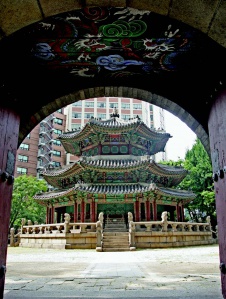"Seoul - 3.1 Transformation of the City Prototype"의 두 판 사이의 차이
잔글 |
|||
| 3번째 줄: | 3번째 줄: | ||
<gallery align="center" widths="300px" heights="300px"> | <gallery align="center" widths="300px" heights="300px"> | ||
File:UKS04_Seoul_img_13.jpg|Photo 6 Hwanggungwu, Symbol of Daehanjeguk | File:UKS04_Seoul_img_13.jpg|Photo 6 Hwanggungwu, Symbol of Daehanjeguk | ||
| − | |||
</gallery> | </gallery> | ||
The Japanese built a series of buildings to symbolize Japanese Colonial Rule in Korea. Japanese Government-General of Korea Building was built inside the main palace of the Joseon Dynasty, Gyeongbokgung, which was the pinnacle of the south/north axis and viewing axis (1925). Gyeongseong City Government Complex was built in front of Deoksugung, the main palace of Daehanjeguk (1925). Joseon Shinto Shrine was built on Namsan (1925). Gyeongseong Shinto Shrine (1898) and Japanese Legation Building (1910) were also built. Korea’s best financial district was constructed that began from the top of the street of Deoksugung to Namsan. As part of this district, Bonjeong (Chungmuro), Myeongchijeong (Myeong-dong), and Hwanggeumjeong (present-day Euljiro) were built below Namsan in addition to Sogongro. The symbolic spatial structure of the Joseon Dynasty was completely transformed into the main axis of colonial rule that connected Japanese Government-General of Korea Building, Gyeongseong City Government Complex and the Bank of Joseon (predecessor of the Bank of Korea). | The Japanese built a series of buildings to symbolize Japanese Colonial Rule in Korea. Japanese Government-General of Korea Building was built inside the main palace of the Joseon Dynasty, Gyeongbokgung, which was the pinnacle of the south/north axis and viewing axis (1925). Gyeongseong City Government Complex was built in front of Deoksugung, the main palace of Daehanjeguk (1925). Joseon Shinto Shrine was built on Namsan (1925). Gyeongseong Shinto Shrine (1898) and Japanese Legation Building (1910) were also built. Korea’s best financial district was constructed that began from the top of the street of Deoksugung to Namsan. As part of this district, Bonjeong (Chungmuro), Myeongchijeong (Myeong-dong), and Hwanggeumjeong (present-day Euljiro) were built below Namsan in addition to Sogongro. The symbolic spatial structure of the Joseon Dynasty was completely transformed into the main axis of colonial rule that connected Japanese Government-General of Korea Building, Gyeongseong City Government Complex and the Bank of Joseon (predecessor of the Bank of Korea). | ||
| − | |||
| − | |||
| − | |||
2017년 1월 13일 (금) 00:39 판
King Gojong, the 26th King of the Joseon Dynasty, proclaimed the founding of Daehanjeguk (the Greater Korean Empire) in 1897 and claimed himself the Emperor. To commemorate this new beginning he moved the main palace to Gyeongwungung (renamed to Deoksugung in 1907) and embarked on the city’s independent modernization process. Yanggwan (Westerners’ Wing) was built inside Gyeongwungung, and he established Hwangudan (a site where rites for the heavens were performed) across Gyeongwungung and reported his enthronement as the emperor to the heavens. As a result, the existing urban center with the Gyeongbokgung Palace as the center was transformed into an urban structure that connects the Gyeongbokgung Palace, Hwangudan and Namdaemun to Gyeongwungung with the latter as the center. Most of the buildings in Gyeongbokgung and Gyeongungung were destroyed or removed in early Japanese colonial rule, and a horizontal axis was formed that connected Gwanghwamun Streets, Deoksugung and Namdaemun in a direct line. As a streetcar route linking Gwanghwamun and Namdaemun was developed in 1928, the streets became even wider. Hwangudan, the symbol of the Joseon Empire, was sold as the site for Joseon Hotel (present-day Westin Chosun Hotel) in 1914. Only Hwanggungwu (Yellow Palace Shrine) remained inside the hotel.
The Japanese built a series of buildings to symbolize Japanese Colonial Rule in Korea. Japanese Government-General of Korea Building was built inside the main palace of the Joseon Dynasty, Gyeongbokgung, which was the pinnacle of the south/north axis and viewing axis (1925). Gyeongseong City Government Complex was built in front of Deoksugung, the main palace of Daehanjeguk (1925). Joseon Shinto Shrine was built on Namsan (1925). Gyeongseong Shinto Shrine (1898) and Japanese Legation Building (1910) were also built. Korea’s best financial district was constructed that began from the top of the street of Deoksugung to Namsan. As part of this district, Bonjeong (Chungmuro), Myeongchijeong (Myeong-dong), and Hwanggeumjeong (present-day Euljiro) were built below Namsan in addition to Sogongro. The symbolic spatial structure of the Joseon Dynasty was completely transformed into the main axis of colonial rule that connected Japanese Government-General of Korea Building, Gyeongseong City Government Complex and the Bank of Joseon (predecessor of the Bank of Korea).
